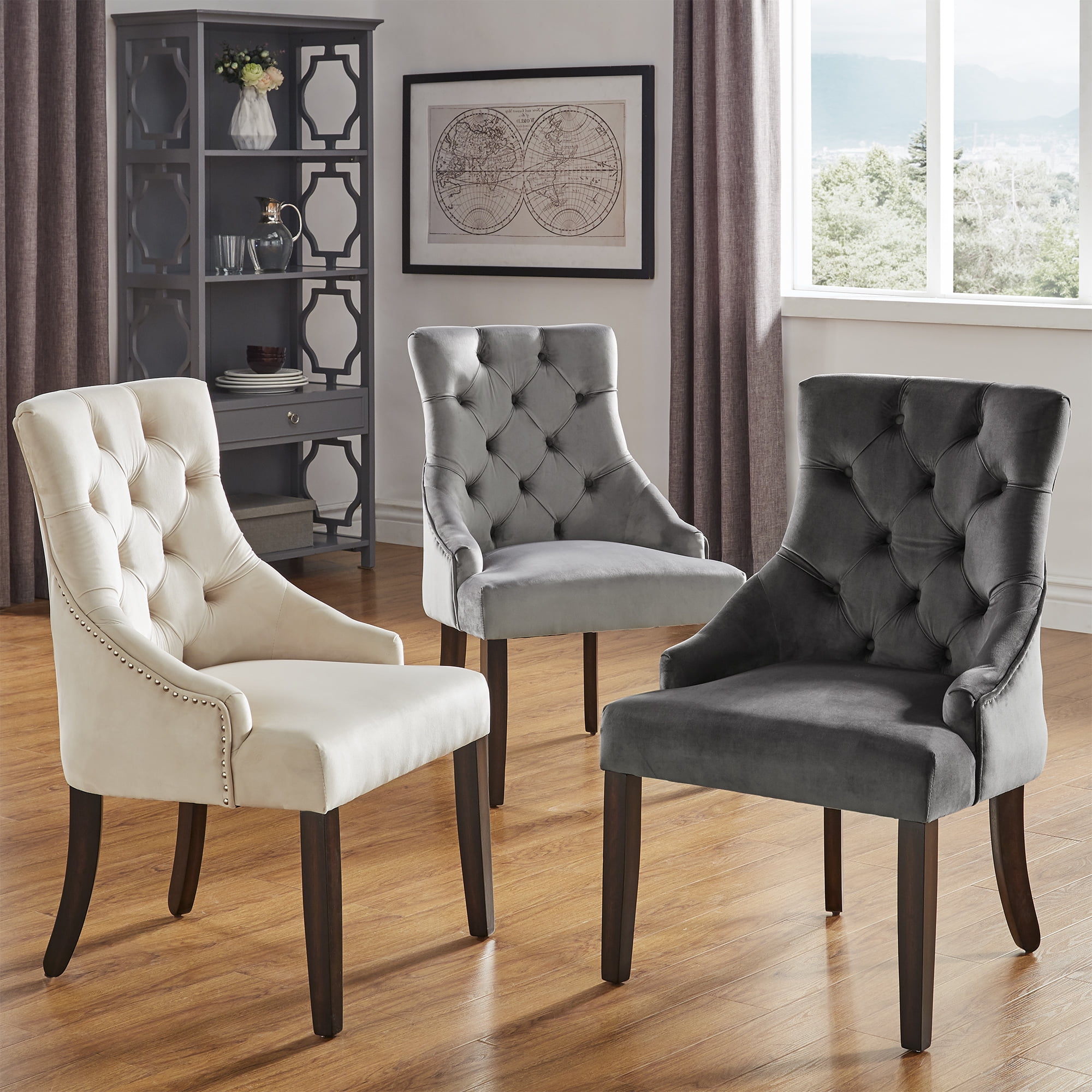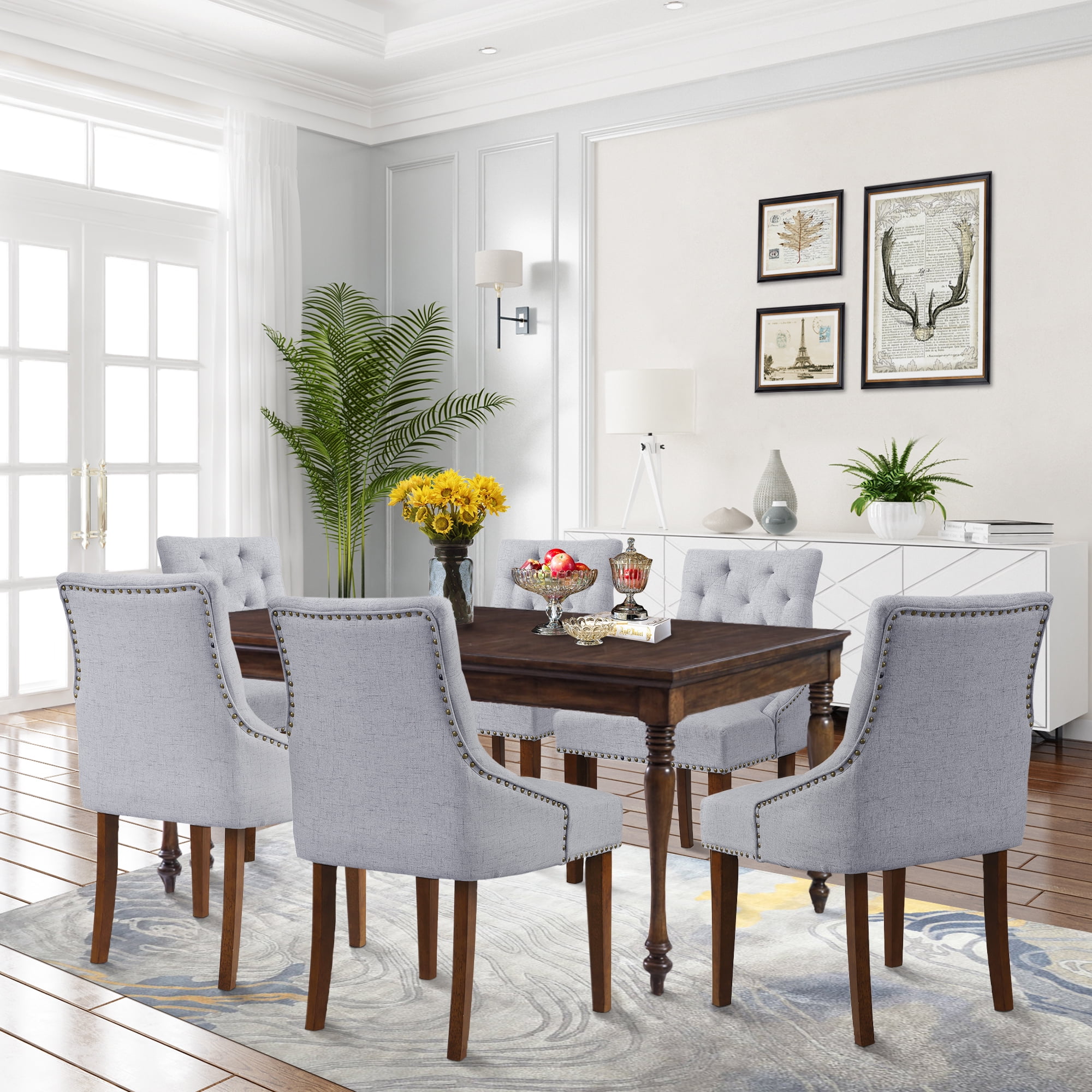Materials & Manufacturing of Grey Upholstered Dining Chairs

Choosing the right dining chair involves considering not only its style but also the durability and environmental impact of its construction. Understanding the materials and manufacturing process allows for a more informed purchase, ensuring a chair that meets both aesthetic and practical needs.
This section delves into the specifics of grey upholstered dining chair production, comparing upholstery fabrics, detailing the manufacturing stages, and examining the environmental considerations involved.
Upholstery Fabric Comparison: Linen, Velvet, and Microfiber
The choice of upholstery fabric significantly impacts a chair’s durability and maintenance requirements. Linen, velvet, and microfiber each offer unique properties.
- Linen: Linen is a natural fiber known for its breathability and luxurious texture. However, it’s less durable than microfiber and requires more careful cleaning. Spills should be addressed immediately, and professional cleaning is often recommended. Its natural variations in texture and color add to its charm, but also mean that it can be more susceptible to staining and wear than other options.
- Velvet: Velvet offers a plush, opulent feel and excellent color saturation. It’s relatively durable, but its delicate pile can be susceptible to crushing or damage from rough handling. Regular vacuuming with a soft brush attachment is crucial to maintain its appearance. While spills can be challenging to remove completely, professional cleaning is often an effective solution.
- Microfiber: Microfiber is a synthetic fabric renowned for its durability and stain resistance. It’s easy to clean and requires minimal maintenance. Spills are generally easily wiped away, making it a practical choice for high-traffic areas. However, it may lack the luxurious feel of linen or velvet, and its synthetic nature might be a concern for environmentally conscious consumers.
Manufacturing Process of a Grey Upholstered Dining Chair
The creation of a grey upholstered dining chair involves a multi-stage process, beginning with raw material sourcing and culminating in final assembly.
The process typically starts with sourcing the raw materials: wood for the frame (often sustainably sourced beech or oak), foam for cushioning, and the chosen upholstery fabric (linen, velvet, or microfiber). These materials are then processed. The wood is cut and shaped using CNC machinery, ensuring precision and consistency. The foam is cut to the required dimensions, often using specialized cutting tools. The upholstery fabric is cut and sewn, typically using industrial sewing machines. The frame is assembled, often using screws, dowels, and glue. The foam is attached to the frame. Finally, the upholstery fabric is carefully stretched and stapled onto the frame, ensuring a taut and smooth finish. Quality control checks are performed at each stage to ensure the chair meets the required standards.
Environmental Impact of Manufacturing Grey Upholstered Dining Chairs
The environmental impact of manufacturing grey upholstered dining chairs is significant, stemming from material sourcing, energy consumption during manufacturing, and waste generation.
The sourcing of sustainably harvested wood for frames is crucial. The use of recycled or repurposed materials in the manufacturing process can reduce the environmental footprint. The manufacturing process itself should aim to minimize energy consumption and waste. Improved manufacturing techniques, such as using less glue or adopting more efficient cutting methods, can reduce waste and energy usage. The choice of upholstery fabric also impacts the environmental impact; opting for natural, sustainably produced fabrics like organic linen reduces the reliance on synthetic materials. Furthermore, exploring biodegradable or recyclable materials for cushioning and other components can significantly contribute to a more sustainable production process. Companies committed to sustainability often implement programs for responsible waste disposal and recycling of manufacturing byproducts.
Grey Upholstered Dining Chairs in Interior Design

Grey upholstered dining chairs offer unparalleled versatility, seamlessly blending into diverse interior styles and adding a touch of sophistication to any dining space. Their neutral tone provides a perfect backdrop for creative expression, allowing you to build a unique and personalized dining area.
Interior Design Ideas Featuring Grey Upholstered Dining Chairs
Grey dining chairs effortlessly adapt to various design aesthetics. Here are five interior design ideas showcasing their adaptability:
Modern Minimalist Dining Room
Imagine a sleek, minimalist dining room featuring grey upholstered dining chairs around a clean-lined, light wood table. The color palette is predominantly white and grey, with pops of black in the lighting and accessories. The overall aesthetic is one of understated elegance and functional simplicity. The grey chairs contribute to the calming and sophisticated ambiance.
Rustic Farmhouse Dining Room
A rustic farmhouse setting benefits from the soft contrast of grey upholstered dining chairs against a reclaimed wood table and distressed wooden flooring. Warm, earthy tones like beige and brown are incorporated through the walls and textiles, creating a cozy and inviting atmosphere. The grey chairs add a touch of refinement to the rustic charm.
Mid-Century Modern Dining Room
Grey upholstered dining chairs with tapered legs perfectly complement a mid-century modern dining table made of walnut or teak. A palette of mustard yellow, teal, and burnt orange adds vibrancy, while the grey chairs maintain a sense of balance and sophistication. The overall design is a harmonious blend of retro style and contemporary elegance.
Scandinavian-Style Dining Room
In a Scandinavian-inspired dining room, grey upholstered dining chairs blend seamlessly with light wood furniture, white walls, and natural textures like linen and wool. A muted color palette of whites, greys, and soft blues creates a feeling of airy spaciousness and tranquility. The grey chairs contribute to the clean and minimalist aesthetic.
Industrial-Style Dining Room
For an industrial-style dining room, grey upholstered dining chairs with metal legs offer a perfect balance between ruggedness and refinement. The color palette typically features greys, blacks, and metallic accents, with exposed brick or concrete adding to the raw, urban aesthetic. The grey chairs add a layer of comfort and sophistication to the industrial setting.
Dining Room Layouts Featuring Grey Upholstered Dining Chairs
The placement of dining chairs significantly impacts the overall flow and functionality of a dining room. Below are three different dining room layouts incorporating grey upholstered dining chairs:
| Room Size & Shape | Table Placement | Chair Placement | Additional Furniture |
|---|---|---|---|
| Small Square Room | Centered in the room | Evenly spaced around the table | A small buffet or sideboard against one wall |
| Medium Rectangular Room | Against one of the longer walls | Evenly spaced around the table, leaving ample walking space | A china cabinet or a serving cart near the table |
| Large Open-Plan Dining Area | As a focal point, potentially using a rug to define the space | Arranged to allow easy access from all sides | Additional seating, such as armchairs, strategically placed around the perimeter |
Rewritten Article on Grey Upholstered Dining Chairs
Grey upholstered dining chairs are exceptionally versatile, easily integrating into diverse design schemes and adding a sophisticated touch to any dining area. Their neutral hue serves as an ideal foundation for creative expression, enabling the development of a personalized and distinctive dining space. The chairs’ adaptable nature makes them a popular choice for homeowners seeking both style and practicality. Various interior styles benefit from the understated elegance and subtle sophistication these chairs provide. Their versatility allows them to be the centerpiece of a room or a quiet complement to bolder design choices. The inherent neutrality of the grey fabric enables seamless integration into a wide array of color palettes and decorative styles. This makes them a practical and stylish choice for a variety of homes and lifestyles.
